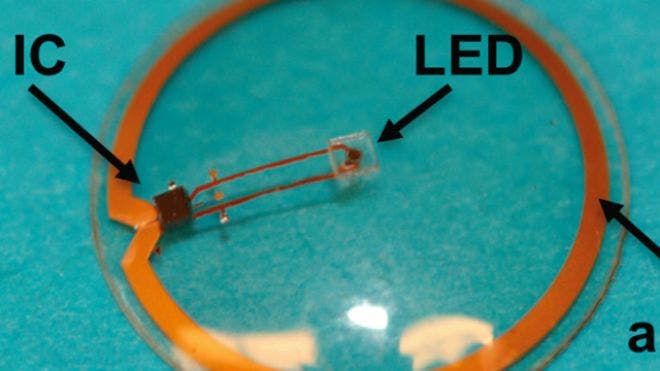A group of ophthalmologists and optoelectronics scientists are currently working on contact lens that can display information directly to the retina. So far the device is quite rudimentary, displaying only one well focused pixel, however further research might allow individuals wearing this special computerized lenses to read e-mails, receive real time notifications of important events or even acquire Terminator-style lock-on. All as easy as blinking an eye.
“Some day maybe we’ll have full-fledged streaming in your contact lenses,” said Babak Amir Parviz, an associate professor of electrical engineering at the University of Washington who co-authored the paper.
The super lens, provisonally titled “single-pixel wireless contact lens display”, is made out of a polymer substrate, light-emitted diode, antenna, and an integrated circuit to harvest the wireless power. At first, the researchers used a special kind of miniature LED to suit their purpose, however they soon found that due to the minimum focal distance required to see anything clearly, it just didn’t cut it. So, the researchers added another layer to the lens which contained an array of special flatter, thinner lenses known as Fresnel lenses, each less than a micron thick.
Displaying the pixel properly was just one of the many hassles researchers faced during the manufacturing process, though. At this kind of scale miniaturization is an extremely daunting process, which required all of the components (most normally fit within a few milimeters even in modern compact applications) to be coated inside the lens at the micrometer scale. Then there’s always the issue of bio-compatibility, especially in such a sensitive area like the eye. The reserachers managed, eventually.
Their initial tests with lab rabbits proved to be highly successful. No signs of abrasions or thermal burning were observed on the surface of the rabbit’s retina. “We have been able to build the whole system and test it on rabbits, on live eyes, and show that this works and it’s safe,” Parviz said.
[RELATED] Cyborg rats with artificial cerebellums
A single pixel might no seem like much, but it’s a start. In their upcoming upgrades, the researchers are planning to increase the pixel count, refine the antenna design, widen the wireless range, and get the components into a softer, more flexible material. Applications for the lens would be limited only to one’s imagination.
“As contact lens based biosensors advance, they may alert the wearer of physiological anomalies, such as irregular glucose or lactate levels. With more colors and increased resolution, contact lenses may display text, be used with gaming devices, or offer cues from navigation systems.”
The paper was recently published in the journal Journal of Micromechanics and Microengineering.











